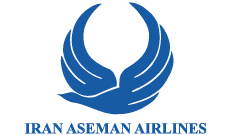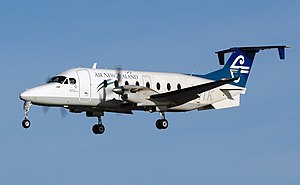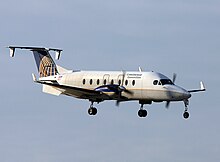US Airways Express was the brand name for the regional affiliate of US Airways, under which a number of individually owned commuter air carriers and regional airlines operate short and medium haul routes. This code sharing service was previously operated as USAir Express. Mainline carriers often outsource to regional airlines to operate services in order to increase frequency, serve routes that would not sustain larger aircraft, or for other competitive reasons. US Airways Express operations were conducted from smaller markets in the United States, Canada, and the Bahamas primarily centered on US Airways' major hubs and focus cities.

The Antonov An-26 is a twin-engined turboprop civilian and military transport aircraft, designed and produced in the Soviet Union from 1969 to 1986.

The Antonov An-28 is a twin-engined light turboprop transport aircraft, developed from the Antonov An-14M. It was the winner of a competition against the Beriev Be-30, for use by Aeroflot as a short-range airliner. It first flew in 1969. A total of 191 were built and 16 remain in airline service as at August 2015. After a short pre-production series built by Antonov, it was licence-built in Poland by PZL-Mielec. In 1993, PZL-Mielec developed its own improved variant, the PZL M28 Skytruck.

The de Havilland DH.114 Heron is a small propeller-driven British airliner that first flew on 10 May 1950. It was a development of the twin-engine de Havilland Dove, with a stretched fuselage and two more engines. It was designed as a rugged, conventional low-wing monoplane with tricycle undercarriage that could be used on regional and commuter routes. A total of 149 were built; it was also exported to about 30 countries. Herons later formed the basis for various conversions, such as the Riley Turbo Skyliner and the Saunders ST-27 and ST-28.

Iran Aseman Airlines is the third-largest Iranian airline headquartered in Tehran. It operates scheduled domestic passenger services and regional international services.
Tassili Airlines is an Algerian passenger airline, based in Algiers, owned by Sonatrach, the national state-owned oil company of Algeria.

Air Midwest Flight 5481 was a Beechcraft 1900D on a regularly scheduled passenger flight from Charlotte Douglas International Airport in Charlotte, North Carolina, to Greenville–Spartanburg International Airport in Greer, South Carolina. On the morning of January 8, 2003, the Beechcraft stalled while departing Charlotte Douglas International Airport and crashed into an aircraft hangar, killing all 21 passengers and crew aboard and injuring one person on the ground.

Alaska Central Express is an airline based at Ted Stevens Anchorage International Airport in Anchorage, Alaska, United States. It is a cargo and small package express service.

Alpine Air Express is an American airline based in Provo, Utah. It operates scheduled and chartered air cargo services on over 100 routes throughout Utah, Montana, Minnesota, Nebraska, North Dakota, South Dakota, Wyoming, Idaho, and Colorado.
Ameriflight LLC is an American cargo airline with headquarters at the Dallas/Fort Worth International Airport. It is the largest United States FAA Part 135 cargo carrier, operating scheduled and contract cargo services from 19 bases to destinations in 250 cities across 43 US states as well as in Canada, Mexico, the Caribbean, and South America. Ameriflight serves major financial institutions, freight forwarders, laboratories, and overnight couriers in the US, and provides feeder services for overnight express carriers nationwide and internationally. Ameriflight averages 525 daily departures with over 100,000 combined flight hours annually and a 99.5% on-time performance. Ameriflight employs over 700 people.

In aviation, a water landing is, in the broadest sense, an aircraft landing on a body of water. Seaplanes, such as floatplanes and flying boats, land on water as a normal operation. Ditching is a controlled emergency landing on the water surface in an aircraft not designed for the purpose, a very rare occurrence. Controlled flight into the surface and uncontrolled flight ending in a body of water are generally not considered water landings or ditching.

As of July 2020, a total of 60 Boeing 747 aircraft, or just under 4% of the total number of 747s built, first flown commercially in 1970, have been involved in accidents and incidents resulting in a hull loss, meaning that the aircraft was either destroyed or damaged beyond economical repair. Of the 60 Boeing 747 aircraft losses, 32 resulted in no loss of life; in one, a hostage was murdered; and in one, a terrorist died. Some of the aircraft that were declared damaged beyond economical repair were older 747s that sustained relatively minor damage. Had these planes been newer, repairing them might have been economically viable, although with the 747's increasing obsolescence, this is becoming less common. Some 747s have been involved in accidents resulting in the highest death toll of any civil aviation accident, the highest death toll of any single airplane accident, and the highest death toll of a midair collision. As with most airliner accidents, the root of cause(s) in these incidents involved a confluence of multiple factors that rarely could be ascribed to flaws with the 747's design or its flying characteristics.

Rumbek Airport is an airport in South Sudan, near Rumbek the capital of Western Lakes State. The airport is served by several national airlines and by air charter service providers.

Colgan Air Flight 9446 was a repositioning flight operated by Colgan Air for US Airways Express. On August 26, 2003, the Beechcraft 1900D crashed into water 300 feet (91 m) offshore from Yarmouth, Massachusetts, shortly after taking off from Barnstable Municipal Airport in Hyannis. Both pilots were killed.
In aeronautics, loss of control (LOC) is the unintended departure of an aircraft from controlled flight and is a significant factor in several aviation accidents worldwide. In 2015 it was the leading cause of general aviation accidents. Loss of control may be the result of mechanical failure, external disturbances, aircraft upset conditions, or inappropriate crew actions or responses.

Aerolift Philippines Flight 075 was a scheduled domestic flight from Ninoy Aquino International Airport to Surigao Airport. On 18 May 1990, the Beechcraft 1900 operating the flight crashed just after takeoff, 1 km south of the airport, killing all 19 passengers and 2 crew, as well as a family of four on the ground. Flight 75 was the second fatal accident of a Beechcraft 1900 and remains the worst loss of life in a crash involving that model.



















